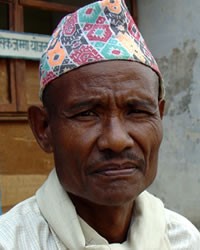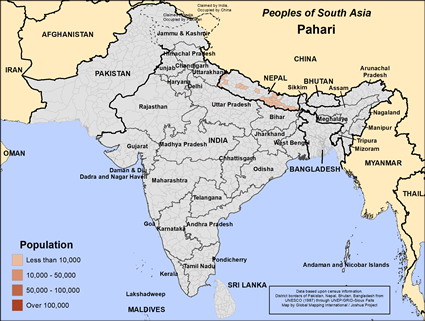Pahari in Nepal

Photo Source:
Copyrighted © 2026
Isudas All rights reserved. Used with permission |

Map Source:
People Group data: Omid. Map geography: UNESCO / GMI. Map Design: Joshua Project.
|
| People Name: | Pahari |
| Country: | Nepal |
| 10/40 Window: | Yes |
| Population: | 14,000 |
| World Population: | 14,000 |
| Primary Language: | Nepali |
| Primary Religion: | Hinduism |
| Christian Adherents: | 2.52 % |
| Evangelicals: | 0.00 % |
| Scripture: | Complete Bible |
| Ministry Resources: | Yes |
| Jesus Film: | Yes |
| Audio Recordings: | Yes |
| People Cluster: | South Asia Hindu - other |
| Affinity Bloc: | South Asian Peoples |
| Progress Level: |
|
Introduction / History
The Pahari people of Nepal, whose native language is Pahari, live in the central hill areas of Nepal. The largest Pahari populations are found in the hilly areas of Central Lalitpur and Central/Northeast Kavre districts at an altitude ranging around 5200 feet, generally along the ridgeline. Some settlements can be found in the lower regions of Rautahat and Makwanpur districts at altitudes of about 640 feet.
What Are Their Lives Like?
The Pahari language and culture is closely related to that of the Newar people. Pahari communities are usually found within larger villages consisting of multiple people groups and are therefore a multilingual society. Of the Pahari people in Nepal only 25% speak their mother tongue of Pahari. Although Pahari people generally think positively of their mother tongue, it is becoming less common for Pahari to be transmitted to the youngest generations since they see greater value in Nepali fluency as it is the language of education and trade.
Traditional Pahari homes are typically made of mud and cow dung, though homes are now being built with cement. It is common for three generations to live under one roof, with the wife moving into her husband's family home. Most homes have electricity (often solar), TV and radio. Most families have access to a water pump. However, because they live on ridgelines, some have issues with wells running dry. Water treatment is generally required. Food includes 2-3 meals a day of rice and lentil sauce with curried vegetables.
Traditionally, Pahari people worked as farmers and weavers of baskets and rugs. Today, most Pahari people farm their own fields growing rice and vegetables, while a few continue to make and sell woven products. It is becoming increasingly common for Pahari people living in the Kathmandu area to commute to the city by public bus or privately owned motorcycle.
Pahari tend to live in multi-ethnic villages and therefore have historically been bilingual or multilingual in Pahari, Nepali and other regional languages. Adults 25 years and older speak Pahari and Nepali. School is taught in Nepali and therefore Pahari children usually learn Nepali as their mother tongue.
What Are Their Beliefs?
The Pahari church is growing in some villages. In Lalitpur, 10-20% of the Pahari population is Christian. In the lower elevation Pahari settlements, about 40% of the Pahari population reports to be Christian.
What Are Their Needs?
Christian Pahari people attend multi-ethnic churches in which the language of worship, prayer, and scripture is in Nepali. There is no scripture available in Pahari. Although there has been no request for translation of the scriptures, some Pahari individuals have indicated interest in oral Bible stories.
National missionaries have been active in Pahari communities in the past decades and Pahari Christians also evangelize their own communities. Cross-cultural missionaries are needed to encourage the Pahari church and help with Bible schooling and pastoral training.
Prayer Points
Pray for a spiritual hunger that will lead the Pahari people to seek and find the Living God.
Pray for Pahari disciples who will make more disciples.
Pray for dedicated workers.